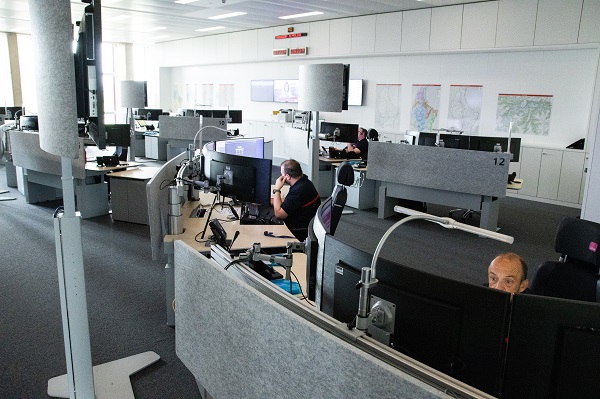 CSU-112 emergency call centre;
Credit: CGDIS
CSU-112 emergency call centre;
Credit: CGDIS
As part of European 112 Day, celebrated each year on 11 February, the Grand Ducal Fire and Rescue Corps (CGDIS) is placing the emphasis in 2024 on the issue of locating emergency calls and the resources made available for this purpose at CSU-112.
When receiving a call, the operators of the CSU-112 emergency call centre first and systematically ask the caller what type of emergency it is. According to the CGDIS, this is in order to be able to prioritise critical situations, falling within its missions.
The second crucial question asked is the location of the emergency in order to be able to mobilise appropriate help as quickly as possible. The caller should ideally provide the exact address or at least share precise details such as: Otherwise, it will be able to transmit precise details such as: an emergency point in the forest (Rettungspunkt); GPS coordinates; a kilometre point on a road; the number of an emergency terminal on a motorway; any striking detail in the surrounding area.
The CGDIS noted that the transmission of such information in a stressful context can generate a substantial loss of time without always allowing fairly precise localisation. In recent years, technological advances have offered innovative and effective solutions for locating calls which in the vast majority of cases come from smartphones these days.
One of the most notable innovations is Advanced Mobile Location (AML), a system that has recently become fully functional in Luxembourg on Android and iOS devices, provided that the necessary updates are installed. This technology automatically transmits the caller's exact location to the CSU-112, without the need for a mobile Internet connection, any particular smartphone configuration or the installation of a specific application. An automatic and free service, AML respects the confidentiality of personal data in accordance with GDPR, deleting information collected after the intervention.
112 teams can also use other complementary localisation methods, including:
- the E-Call system (mandatory in the EU for all vehicles produced after 2018), which automatically issues a free emergency call in the event of an accident causing the airbags to be triggered. It can also be triggered by manually activating a button in the passenger compartment. E-Call automatically transmits essential information such as the exact location of the vehicle, the time of the accident, the vehicle number plate and the direction of travel:
- the smart locator, another solution used to precisely locate emergency calls in real time in the absence of AML. It involves sending an SMS containing a link from CSU-112 to the caller's smartphone. By opening this link on a mobile phone connected to the Internet, the caller allows 112 to access their location;
- the GouvAlert government mobile application, whose main function is to broadcast alerts to the population about major incidents. It also offers the possibility of directly contacting 112 and calls generated via the application are automatically geolocated.
The CGDIS described this range of caller localisation tools as a step forward for effective and rapid intervention by emergency services, which is one of the objectives of the national emergency organisation plan (PNOS).
The CGDIS also recalled that the emergency number 112 should only be used in cases of emergency. In 2023, almost two thirds of the 276,353 calls received did not correspond to emergency situations. This inappropriate use of the emergency number can in the worst case hamper the effectiveness of emergency interventions.








